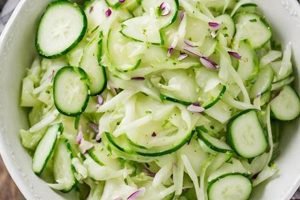Sunomono, a refreshing Japanese dish featuring thinly sliced cucumbers in a sweet and sour vinegar-based dressing, often accompanies sushi meals. Variations may include seaweed, sesame seeds, or other vegetables, enhancing flavor and textural complexity. This preparation complements the richness of sushi with its light, acidic profile, cleansing the palate between bites.
This accompaniment plays a vital role in the overall sushi dining experience. The balanced flavors and crisp texture provide a refreshing counterpoint to the often-rich fish and rice. Historically, the acidic marinade served a practical purpose, acting as a mild preservative before refrigeration was widely available. Today, it remains a beloved element of Japanese cuisine, appreciated for its culinary and cultural significance.
The following sections will explore various sunomono recipes, ranging from traditional preparations to modern adaptations, offering guidance on ingredient selection, techniques, and presentation.
Tips for Preparing a Cucumber Salad Complement for Sushi
Achieving optimal flavor and texture in a cucumber salad designed to accompany sushi requires attention to detail. The following tips offer guidance for creating a successful complement to the main course.
Tip 1: Cucumber Selection: Opt for Japanese cucumbers, Persian cucumbers, or English cucumbers due to their thin skin and minimal seeds. These varieties contribute a delicate crunch and avoid excess moisture in the salad.
Tip 2: Thin Slicing: Employing a mandoline or sharp knife ensures uniformly thin cucumber slices, maximizing surface area for marinade absorption and contributing to a pleasant texture.
Tip 3: Salting and Draining: Lightly salting the sliced cucumbers and allowing them to drain for 15-20 minutes draws out excess moisture, preventing a watery salad and concentrating flavor.
Tip 4: Marinade Balance: The hallmark of a successful sunomono lies in the balance of sweet, sour, and salty elements in the marinade. Rice vinegar, sugar, and salt form the foundation, with mirin or sake often added for depth.
Tip 5: Ingredient Incorporation: Seaweed, such as wakame or aonori, offers a subtle umami note, while toasted sesame seeds provide nutty fragrance and visual appeal. Incorporate these elements judiciously to complement the cucumber’s delicate flavor.
Tip 6: Chilling Time: Allowing the salad to chill for at least 30 minutes, or ideally longer, allows the flavors to meld and the cucumbers to absorb the marinade fully.
Tip 7: Presentation: Consider serving the salad in small, individual bowls for a refined presentation, further enhancing the dining experience.
By following these tips, one can create a refreshing and flavorful cucumber salad that enhances the sushi experience. A well-executed sunomono provides a palate cleanser and textural contrast, elevating the overall meal.
These preparation techniques contribute significantly to a well-rounded sushi dining experience. The following section offers concluding remarks on the art of pairing this refreshing accompaniment with sushi.
1. Refreshing
The refreshing quality of a cucumber salad (sunomono) plays a crucial role in its pairing with sushi. The primary contributing factors are the cucumber itself, the preparation method, and the marinade. Cucumbers, particularly varieties like Japanese or English cucumbers, possess a naturally high water content and mild, cooling flavor. Thin slicing maximizes surface area, enhancing the perception of coolness. The marinade, typically composed of rice vinegar, sugar, and salt, contributes a bright acidity that cleanses the palate. This acidity, combined with the cool cucumber, creates a refreshing sensation that cuts through the richness of the fish and rice in sushi, preparing the palate for the next bite.
Consider the experience of consuming a piece of fatty tuna nigiri followed by a bite of sunomono. The fattiness of the tuna coats the palate, while the rice provides a starchy base. The crisp, cool cucumber and the acidic marinade effectively cut through these sensations, leaving the palate refreshed and ready for the next piece of sushi. This interplay of contrasting sensations highlights the importance of the refreshing element in the overall dining experience. Without this counterpoint, the richness of the sushi could become overwhelming, potentially diminishing enjoyment over the course of the meal.
The refreshing aspect of sunomono is not merely a pleasant sensory experience; it contributes significantly to the balance and harmony of a sushi meal. The interplay of flavors and textures creates a dynamic and engaging culinary experience. By understanding the elements that contribute to this refreshing quality, one can appreciate the intentionality and artistry behind this seemingly simple accompaniment. This knowledge also empowers individuals to prepare sunomono that effectively complements the specific types of sushi being served, further enhancing the overall dining experience.
2. Cleansing Palate
The palate-cleansing function of cucumber salad, specifically within the context of sushi consumption, is essential for a balanced and enjoyable dining experience. The richness and varied flavors of sushi, ranging from fatty tuna to delicate white fish, require a neutral element to prevent sensory overload and allow full appreciation of each individual piece. Cucumber salad serves this purpose effectively, preparing the palate for subsequent flavors.
- Acidity:
The primary palate-cleansing agent in cucumber salad is the vinegar-based dressing. The acidity cuts through the richness of fish and the starchiness of rice, effectively neutralizing the palate. This allows the diner to experience the full flavor profile of each sushi piece without lingering tastes from previous bites. Consider the contrast between a rich, oily salmon nigiri and a bite of lightly pickled cucumber; the acidity of the cucumber resets the palate, allowing the subtle nuances of the next piece of sushi to shine through.
- Texture:
The crisp, cool texture of the cucumber itself provides a refreshing contrast to the often-soft textures of sushi. This textural variation further enhances the palate-cleansing effect. The snap of the cucumber against the teeth provides a physical cleansing sensation, complementing the chemical cleansing provided by the vinegar. Imagine the difference between a creamy scallop roll and a bite of crunchy cucumber; the contrasting textures provide a welcome break and prepare the mouth for the next culinary experience.
- Simplicity:
The simple, clean flavors of cucumber salad avoid overpowering the delicate flavors of the sushi. The mildness of the cucumber and the balanced sweetness and acidity of the dressing create a neutral backdrop against which the flavors of the fish and rice can stand out. This understated profile is key to its effectiveness as a palate cleanser; a complex or heavily flavored salad would compete with the sushi, rather than complementing it.
- Digestive Aid:
The digestive properties attributed to vinegar, ginger and sometimes present seaweed in cucumber salad, can further enhance the dining experience by aiding digestion, particularly when consuming richer sushi varieties. While not strictly a palate-cleansing function, this aspect contributes to the overall sense of lightness and refreshment that cucumber salad brings to a sushi meal.
These elements work in concert to establish cucumber salad as an essential component of the sushi dining experience. More than a simple side dish, it plays a critical role in balancing flavors, cleansing the palate, and preparing the diner for the full spectrum of tastes and textures offered by sushi. The interplay of these factors creates a harmonious culinary experience where each element contributes to the overall enjoyment of the meal.
3. Balancing Flavors
Balance forms the cornerstone of Japanese cuisine, and the role of cucumber salad (sunomono) in a sushi meal exemplifies this principle. Sushi presents a complex interplay of flavors and textures: the richness of fish, the subtle sweetness of rice, the salinity of soy sauce, and the pungency of wasabi. Sunomono, with its contrasting flavors and textures, provides a crucial counterpoint, preventing any single element from dominating the palate.
The balance within sunomono itself is equally vital. The dominant flavor profile revolves around the interplay of sweet, sour, and salty. Rice vinegar provides the sourness, balanced by sugar or mirin. Salt enhances both, creating a harmonious blend. This balance, however, is not static. Variations exist, with some recipes emphasizing sweetness, others highlighting acidity. The specific balance often depends on the accompanying sushi; a lighter, sweeter sunomono may complement richer fish, while a more acidic version might pair better with milder seafood. Further complexity can be introduced through additions like seaweed, ginger, or chili flakes, each contributing unique flavors and textures that further refine the overall balance.
Consider a scenario where a meal consists of several types of nigiri, including fatty tuna (otoro), lean tuna (akami), and yellowtail (hamachi). The otoro, rich and buttery, benefits from the acidity of the sunomono, which cuts through the richness and prepares the palate for the next piece. The akami, leaner and milder, is complemented by the subtle sweetness and refreshing cucumber, enhancing its delicate flavor. The hamachi, with its slightly oily texture, finds balance in the combination of sweet, sour, and salty notes. The sunomono, therefore, acts as a dynamic element, adapting its role based on the specific sushi being consumed. Understanding this interplay of flavors highlights the sophistication and intentionality behind this seemingly simple dish, demonstrating its essential role in creating a harmonious and balanced sushi meal.
4. Textural Contrast
Textural contrast forms a significant element in the enjoyment of sushi, and cucumber salad (sunomono) contributes substantially to this aspect of the dining experience. Sushi often features soft, yielding textures: the delicate flesh of fish, the stickiness of rice, and the smooth texture of nori. Sunomono offers a contrasting crispness and coolness, creating a dynamic interplay that elevates the meal beyond mere sustenance.
- Crisp Cucumber:
The primary textural contrast in sunomono comes from the cucumber itself. Thinly sliced and lightly pickled, it retains a crisp, refreshing bite that offsets the softer textures of sushi. This contrast is particularly noticeable when paired with nigiri or sashimi, where the difference between the yielding fish and the crunchy cucumber is pronounced. The snap of the cucumber provides a satisfying counterpoint to the smooth, sometimes gelatinous, texture of certain fish.
- Tender Seaweed (Optional):
The potential addition of seaweed, such as wakame, introduces another layer of textural complexity. Wakame’s slippery, slightly chewy texture provides a subtle contrast both to the cucumber and the sushi itself. This interplay of textures creates a more dynamic and engaging mouthfeel, further enhancing the dining experience. The delicate strands of seaweed offer a gentle resistance against the teeth, contrasting with the crisp cucumber and soft fish.
- Crunchy Sesame Seeds (Optional):
Toasted sesame seeds, often sprinkled atop sunomono, contribute a subtle crunch and nutty flavor. While not as pronounced as the cucumber’s crispness, the seeds add a delicate textural variation and enhance the visual appeal of the dish. Their small size provides a delicate textural counterpoint to the larger pieces of cucumber and sushi.
- Silky Marinade:
The marinade, while primarily contributing flavor, also plays a textural role. The thin, slightly viscous liquid coats the cucumber slices, creating a subtle silken sensation in the mouth. This delicate coating provides a textural bridge between the crisp cucumber and the softer elements of the sushi, enhancing the overall harmony of the meal. The marinade’s subtle viscosity contrasts with both the dry, airy rice and the moist fish.
These textural elements work together to create a multi-faceted sensory experience. The interplay of crispness, tenderness, and subtle crunch elevates the enjoyment of sushi beyond simply taste and aroma. The contrasting textures provide a dynamic and engaging mouthfeel, ensuring that each bite offers a unique and satisfying experience. This attention to textural detail underscores the sophistication and artistry of Japanese cuisine, demonstrating how even a seemingly simple dish like sunomono can contribute significantly to the overall dining experience.
5. Simple Ingredients
The simplicity of ingredients in cucumber salad, often served with sushi (sunomono), contributes significantly to its refreshing nature and its effectiveness as a palate cleanser. The core components typically include cucumbers, rice vinegar, sugar, and salt. This minimalist approach allows the natural flavors of the cucumber to shine through, while the vinegar provides a clean, bright acidity. Avoiding complex or overpowering ingredients ensures the salad doesn’t compete with the delicate flavors of the sushi, but rather complements them. For example, a simple sunomono made with thinly sliced Japanese cucumbers, seasoned with rice vinegar, sugar, and a pinch of salt, offers a refreshing counterpoint to the richness of fatty tuna or the subtle sweetness of shrimp. The clean flavors of the salad cleanse the palate, preparing it for the next piece of sushi without lingering aftertastes.
This emphasis on simple ingredients also has practical implications. Sunomono can be prepared quickly and easily with readily available ingredients. This accessibility makes it a convenient and versatile dish, suitable for both home cooks and professional sushi chefs. Furthermore, the simplicity of the ingredients allows for variations and customization. Adding a sprinkle of toasted sesame seeds introduces a nutty aroma and a subtle crunch, while a few strips of wakame seaweed contribute a nuanced umami note. These additions, while simple, can significantly enhance the complexity and enjoyment of the salad without compromising its refreshing quality. Consider a variation where thinly sliced ginger is added to the sunomono; the ginger’s subtle spiciness and aroma complement the clean flavors of the cucumber and vinegar, adding another dimension to the dish without overpowering it.
The reliance on simple, high-quality ingredients underscores the essence of Japanese cuisine, where freshness and purity of flavor are paramount. The minimalist approach in sunomono allows the natural flavors of the ingredients to shine through, creating a refreshing and harmonious counterpoint to the complex flavors of sushi. This simplicity, combined with the ease of preparation and versatility, makes sunomono a valuable and enduring component of the sushi dining experience. The ability to adapt and enhance the basic recipe with minimal additions allows for a personalized experience tailored to complement the specific sushi being served. This balance of simplicity and adaptability contributes to sunomono’s enduring appeal and its essential role in the art of sushi.
6. Easy Preparation
The ease of preparation associated with cucumber salad (sunomono), particularly within the context of a sushi meal, contributes significantly to its appeal. Often prepared while the main sushi components are being assembled, sunomono requires minimal cooking and readily available ingredients, making it a practical and efficient addition to the meal. This simplicity allows focus to remain on the more intricate aspects of sushi preparation, while still providing a crucial balancing element.
- Minimal Processing:
Sunomono’s preparation involves minimal processing of ingredients. Cucumbers require only slicing, and other components, such as seaweed or sesame seeds, are often used in their readily available forms. This streamlined approach minimizes preparation time and complexity, allowing for efficient multitasking in the kitchen. For example, while sushi rice is cooling and fish is being sliced, the cucumber can be quickly prepared and marinating.
- Short Marinating Time:
The marinating process for sunomono is relatively short, often requiring only 15-30 minutes for the cucumbers to absorb the flavors of the dressing. This allows for a quick turnaround, ensuring the salad is ready to serve alongside the freshly prepared sushi. The brief marinating time makes sunomono a practical dish to prepare alongside other components of a sushi meal, maximizing efficiency without sacrificing flavor.
- Basic Equipment:
Preparing sunomono necessitates minimal specialized equipment. A sharp knife or mandoline for slicing cucumbers and a bowl for marinating are typically sufficient. This accessibility eliminates the need for specialized tools, making it an approachable dish for home cooks and professionals alike. The basic equipment requirements make sunomono a versatile dish, easily prepared in various settings.
- Adaptability:
The basic sunomono recipe provides a foundation for numerous variations. Ingredients such as different types of seaweed, sesame seeds, ginger, or chili flakes can be incorporated easily to create customized flavor profiles. This adaptability makes sunomono a versatile accompaniment, easily tailored to complement specific types of sushi or individual preferences. For instance, a spicier sunomono with chili flakes may complement lighter white fish, while a sweeter variation with added mirin might enhance the richness of fatty tuna. This flexibility ensures the salad remains a relevant and adaptable component of the sushi dining experience.
These facets of easy preparation contribute significantly to the practical appeal of incorporating sunomono into a sushi meal. The minimal processing, short marinating time, basic equipment requirements, and adaptability allow for efficient preparation and customized flavor profiles, making it a valuable and versatile accompaniment. By minimizing the time and effort required, sunomono allows the focus to remain on the artistry and precision of sushi preparation, while still providing a crucial element of balance and refreshment to the overall dining experience. The ease with which sunomono can be adapted to individual preferences and specific sushi combinations further solidifies its role as a valuable component of a well-rounded sushi meal.
7. Versatile Variations
The inherent versatility of cucumber salad (sunomono) contributes significantly to its enduring presence in sushi cuisine. Adaptability to various flavor profiles and ingredient combinations allows sunomono to complement a wide range of sushi types, enhancing the overall dining experience. This adaptability stems from the simplicity of the core recipe, which provides a neutral foundation upon which diverse flavors and textures can be built. The basic combination of cucumber, rice vinegar, sugar, and salt acts as a blank canvas, allowing for customization based on the specific characteristics of the accompanying sushi.
Consider the pairing of a richer, fattier fish like tuna (otoro) with a sunomono variation featuring thinly sliced ginger and a touch of mirin. The ginger’s subtle spiciness and the mirin’s sweetness cut through the richness of the fish, creating a balanced and harmonious flavor profile. Conversely, a lighter white fish, such as sea bass, might benefit from a sunomono with a higher proportion of rice vinegar, emphasizing acidity and providing a refreshing counterpoint to the fish’s delicate flavor. Further variations can be explored through the inclusion of different types of seaweed, such as wakame or aonori, each contributing unique umami notes and textural nuances. The addition of toasted sesame seeds offers a nutty aroma and a subtle crunch, further enhancing the complexity of the salad.
The practical significance of this versatility lies in the ability to tailor the sunomono to individual preferences and specific sushi selections. This adaptability ensures the salad remains a relevant and complementary component of the meal, regardless of the specific sushi being served. The ability to adjust the sweetness, acidity, and textural elements of the sunomono allows for a customized and harmonious dining experience. Understanding the interplay of flavors and textures within both the sunomono and the sushi itself empowers one to create combinations that enhance the overall enjoyment of the meal. This versatility ensures that sunomono remains a dynamic and valuable element of sushi cuisine, capable of adapting to a wide range of flavors and preferences.
Frequently Asked Questions
This section addresses common inquiries regarding the preparation and role of cucumber salad (often referred to as sunomono) within the context of sushi cuisine.
Question 1: What type of cucumber is best suited for sunomono?
Japanese cucumbers, Persian cucumbers, or English cucumbers are preferred due to their thin skin, minimal seeds, and delicate flavor. These varieties offer optimal texture and minimize excess moisture in the salad.
Question 2: Why is salting and draining the cucumbers important?
Salting draws out excess moisture, preventing a watery salad and concentrating the cucumber’s flavor. This step contributes to a crisper texture and allows the marinade to penetrate more effectively.
Question 3: What is the essential balance of flavors in a sunomono dressing?
The dressing should achieve a harmonious balance of sweet, sour, and salty elements. Rice vinegar contributes acidity, sugar or mirin adds sweetness, and salt enhances both. Specific ratios can be adjusted based on personal preference and the accompanying sushi.
Question 4: How long should the cucumbers marinate?
A minimum of 15-30 minutes allows sufficient time for the cucumbers to absorb the dressing’s flavors. Longer marinating times, up to several hours, can intensify the flavor, but avoid excessive marinating, which can make the cucumbers overly soft.
Question 5: Can other vegetables be added to cucumber salad?
While cucumber forms the foundation, other vegetables, such as thinly sliced carrots, daikon radish, or wakame seaweed, can complement the salad. Select vegetables that offer contrasting textures and flavors without overpowering the cucumber.
Question 6: What is the primary function of cucumber salad when served with sushi?
Cucumber salad serves as a palate cleanser, providing a refreshing counterpoint to the richness of fish and the starchiness of rice. The acidity of the dressing cuts through these heavier elements, preparing the palate for subsequent bites and enhancing the overall dining experience.
Understanding these fundamental aspects of sunomono preparation and its role in a sushi meal enhances appreciation for this seemingly simple yet crucial element of Japanese cuisine. Proper preparation and thoughtful ingredient selection elevate sunomono beyond a mere side dish, transforming it into a vital component of a balanced and enjoyable sushi experience.
The subsequent sections will delve into specific sunomono recipes, demonstrating practical applications of these principles.
Cucumber Salad Recipe Sushi
Exploration of the role of cucumber salad within sushi cuisine reveals its significance beyond a simple side dish. Analysis of preparation techniques, ingredient selection, and flavor profiles underscores the salad’s function as a palate cleanser, flavor balancer, and textural contrast. Its simple yet versatile nature allows for adaptation to complement diverse sushi selections, enhancing the overall dining experience through carefully balanced flavor profiles and refreshing qualities.
Mastery of cucumber salad preparation offers a pathway to a more nuanced appreciation of sushi’s complex interplay of flavors and textures. Further exploration of regional variations and personalized adaptations promises continued evolution and refinement of this essential culinary element, enriching the ongoing cultural significance of sushi cuisine.






